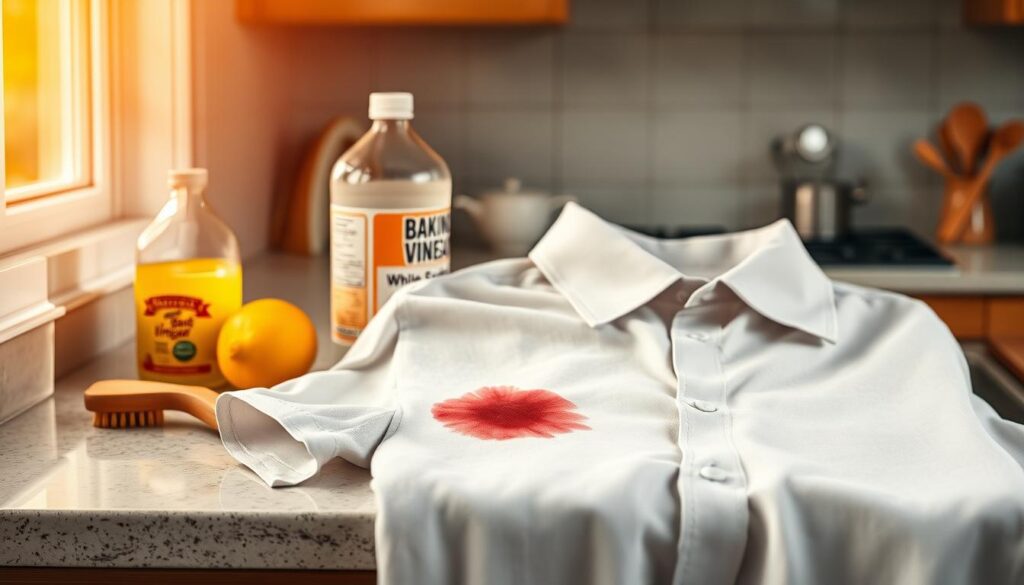Does that yellow ring under your arms mean your favorite shirts are doomed? Sweat stains don’t have to ruin your wardrobe. This guide shares expert-backed methods to tackle even the toughest sweat marks on shirts and undershirts. From fresh spills to set-in stains, we cover solutions that work with items you already own.
Sweat stains happen when sweat mixes with clothing dyes and detergents, leaving unsightly yellow or dingy marks. But with the right approach, you can eliminate these stains before they become permanent. This article breaks down step-by-step techniques, natural remedies, and prevention tips. Learn how to protect your clothes and restore their original look.
Key Takeaways
- Cold water stops stains from setting immediately.
- Baking soda and vinegar remove stains without harsh chemicals.
- Wash shirts in hottest water safe for the fabric.
- Avoid fabric softeners when treating stains.
- Some stains need professional cleaning if home methods fail.
Understanding Sweat Stains and Their Causes
Sweat stains aren’t just wet marks—they’re chemical reactions trapped in fabric. When sweat mixes with skin oils and antiperspirant ingredients, it creates visible yellow or brown discolorations. This process explains why remove perspiration stains requires more than regular washing.
What Are Sweat Stains?
Sweat itself is mostly water, but the yellow marks come from proteins in sweat bonding with aluminum salts in antiperspirants. Over time, these compounds break down, leaving behind stubborn stains. Natural body oils also play a role, trapping the reaction close to fabric fibers.
Why Do They Happen?
Aluminum zirconium, a common antiperspirant ingredient, reacts with sweat’s amino acids during washing. This forms insoluble complexes that cling to fabric. People with higher protein levels in their sweat—like those with active lifestyles—are more prone to these stains. Heat and humidity worsen the reaction, making eliminating sweat stains from clothes harder if ignored.
Types of Fabrics Affected
- White cotton: Light colors show stains immediately, while dark fabrics hide them but retain odors.
- Blends like polyester: Synthetic fabrics resist visible stains but trap moisture, causing lingering smells.
- Delicate materials: Silk or rayon need gentler treatments to avoid damaging the fabric during stain removal.
Essential Supplies for Stain Removal
Before tackling sweat stains, gather the right tools. The right supplies simplify the process and improve results. Here’s what to have on hand:
Common Household Items
Many household items work as sweat stain removal products. Use these to pre-treat stains:
- Baking soda: Neutralizes odors and absorbs moisture.
- White vinegar: Breaks down proteins in sweat with acetic acid.
- Hydrogen peroxide: Oxidizes stains without damaging fabric.
- Dish soap: Cuts through grease and oils in sweat.
- Salt: Absorbs moisture and loosens surface stains.
Laundry Detergents
Choose detergents with enzymes to tackle protein-based stains. Top picks include:
- Tide with Ultra Clean: Enzymes break down sweat proteins.
- Persil ProClean: Contains surfactants for deep cleaning.
- OxiClean Max Force: Oxidizing agents lift stubborn stains.
Stain Removal Products
Specialized best methods for removing sweat stains require targeted products. Compare options below:
| Product Type | Best For | Key Ingredients |
|---|---|---|
| Spray solutions | Fresh or set-in stains | Enzymes, hydrogen peroxide |
| Stain sticks | Spot treatments | Acetone, alcohol-based |
| Laundry boosters | Heavy-duty stains | Oxygen bleach, citric acid |
Products like Shout Advanced or Resolve Stain Stick provide targeted solutions. Always check fabric care labels before use.
Pre-Treatment Methods for Fresh Stains
Quick action stops sweat stains before they set. Mastering DIY sweat stain removal and effective sweat stain removal techniques
Quick Action Steps
- Blot, don’t rub: Use a clean cloth to absorb moisture without spreading the stain.
- Avoid heat: Never use heat; it bonds sweat proteins to fabric fibers.
- Test first: Check care labels before using any product on delicate fabrics.
Using Cold Water
Cool water loosens proteins in sweat. Rinse stained areas under running tap water. For persistent stains, soak fabric in cold water mixed with a drop of dish soap. Soak 15-30 minutes to dissolve oils. Never use hot water—it hardens sweat salts into fabric.
Applying Stain Removers
Choose between store-bought (like OxiClean or Shout) or homemade solutions. Apply gel or liquid removers directly to the stain, working from the edge inward. Let sit 5-10 minutes. For DIY options, mix baking soda with hydrogen peroxide to form a paste. Rinse thoroughly to avoid residue.
Natural Remedies for Stain Removal

Looking for DIY sweat stain removal solutions? These laundry hacks for sweat stains use pantry staples to tackle stains without harsh chemicals. Test on fabric edges first and follow these step-by-step guides.
Baking Soda Paste
Mix 3 parts baking soda with 1 part water to form a thick paste. Apply directly to stains, let sit 15 minutes, then scrub gently. Rinse thoroughly before washing. The alkaline in baking soda neutralizes sweat’s acidic residue, lifting yellow marks from cotton and synthetic fabrics alike.
White Vinegar Solution
- Pour ½ cup white vinegar into a bowl
- Add 2 cups warm water
- Soak stained clothes for 30 minutes
Vinegar’s acetic acid dissolves mineral deposits left by sweat, breaking down deodorant buildup. Rinse well to avoid lingering smells.
Lemon Juice Power
Combine equal parts lemon juice and water. Dab mixture onto stains, then let sit in sunlight for 1 hour. The citric acid acts as a natural bleach. Rinse immediately to prevent color fading on dark fabrics.
Combine methods for tough stains: pre-treat with baking soda, soak in vinegar, then air-dry with lemon juice. These remedies work best on light-colored fabrics and may require multiple tries for older stains. Pair with regular laundry cycles for lasting results.
Effective Techniques for Old Stains
Old sweat stains demand patience and targeted approaches. The best methods for removing sweat stains involve combining time, chemistry, and precision to lift embedded residues. Start by evaluating fabric labels to avoid damage.
Soaking Solutions
For effective sweat stain removal techniques, create customized soaks:
- Oxygen Bleach Soak: Mix 1/2 cup oxygen-based cleaner (e.g., OxiClean) in warm water. Soak for 1–8 hours depending on stain age.
- Enzyme Treatment: Use liquid enzyme cleaners like Biz or Nellie’s All Natural for protein-based stains. Let sit overnight.
- Hydrogen Peroxide: Combine 3% hydrogen peroxide with dish soap. Test on fabric first; soak 30–60 minutes.
Scrubbing Techniques
Gentle agitation is key. Use a soft toothbrush or nylon scrub pad in circular motions. Focus on stained areas without rubbing too hard. For heavy buildup, apply baking soda paste first then scrub.
Professional Cleaning Options
When home methods fail, consult experts. Dry cleaners specializing in garment restoration (e.g., The Laundress or local textile restoration services) use industrial-grade solvents. Always disclose prior treatments to avoid conflicting chemicals. Specialty services may employ steam cleaning or UV light treatments for delicate fabrics.
Preventing Sweat Stains in the Future
Protect your wardrobe with these proactive strategies. Follow sweat stain removal tips to avoid yellow marks on shirts and undershirts fabrics. Preventing stains starts with smart choices in clothing, hygiene, and laundry routines.

Choosing the Right Fabrics
Opt for moisture-wicking fabrics like merino wool or synthetic blends from brands like Nike Dri-FIT or Lululemon. Darker colors and patterned shirts hide stains better than white or light hues. Avoid cotton, which traps sweat and promotes discoloration.
Using Antiperspirants
Antiperspirants block sweat glands. Brands like CertainDri or Secret Clinical Strength reduce wetness. Apply at night for full absorption. For sensitive skin, try aluminum-free options like Schmidt’s Natural Deodorant.
Regular Laundry Practices
Wash sweaty clothes within 24 hours to stop stains from setting. Pre-treat underarms with detergent before washing. Use sweat shields like Odor-Eaters pads to block transfer. Avoid fabric softeners, which trap residue—save those for final rinse cycles.
Combine these steps with How to Remove Sweat Stains from Shirts & Undershirts techniques for long-term results. Consistency in prevention keeps fabrics looking fresh longer.
Washing Techniques for Best Results
Master the right washing techniques to tackle stubborn sweat stains. These laundry hacks for sweat stains ensure clothes stay fresh and clean. Discover how to eliminating sweat stains from clothes with science-backed methods.
Temperature Settings
Cold water works best for fresh stains, preventing proteins in sweat from setting. For older stains, warm water helps break down residues. Always check fabric care labels—silk or wool need cooler settings to avoid damage.
Recommended Wash Cycles
- Delicate Cycle: Use for dress shirts or thin fabrics to protect fibers.
- Heavy-Duty Cycle: Ideal for gym clothes with tough stains, agitating longer for deep cleaning.
- Pretreat Cycle: Modern machines with this option can target stained areas before the main wash.
Avoiding Fabric Softeners
“Fabric softeners leave residue that traps stains, making them harder to remove.”
Opt for alternatives like white vinegar in the rinse cycle or wool dryer balls. These soften fabrics without blocking pores, ensuring eliminating sweat stains from clothes stays effective.
Drying and Ironing Tips
Proper drying and ironing protect your shirts after using sweat stain removal products. Skipping these steps can leave residues that reactivate stains later.
Air Drying vs. Machine Drying
Avoid heat that traps moisture:
- Air drying: Hang shirts on hangers to keep collars and sleeves flat. Let them dry away from direct sunlight to prevent discoloration.
- Machine drying: Use low heat settings. Check fabrics first—heat can set remaining remove perspiration stains residues permanently.
Ironing Precautions
Apply care to avoid damaging treated fabrics:
- Set irons to low heat. Test on a hidden seam first.
- Place a cloth between the iron and fabric to block contact with any remaining treatment residue.
- Avoid ironing stained areas until they’re fully treated and dried.
Storing Clothes Properly
| Method | Benefit |
|---|---|
| Air-dry completely before storage | Eliminates trapped moisture that causes mildew, which can mimic stains |
| Use breathable garment bags | Prevents odors that attract perspiration buildup |
| Hang in open spaces | Reduces moisture retention in closets |
Proper storage ensures treated clothes stay stain-free longer. Follow these steps to maintain results from your sweat stain removal products.
When to Seek Professional Help
Even with the best effective sweat stain removal techniques, some stains may resist home treatments. Knowing when to stop DIY efforts and consult a professional ensures your garments get the right care.
Signs of Permanent Stains
Check for lasting damage. Stains that change fabric texture, resist color fading, or worsen after heat drying signal permanent damage. Persistent yellowing on cotton or discoloration on silk are clear warning signs. Continuing home efforts may harm the fabric further.
Professional Cleaning Services
Specialized services use advanced sweat stain removal products and equipment. Dry cleaners often apply enzyme-based treatments or ozone technology to break down organic stains. Specialty restoration services may use steam cleaning or UV light for delicate materials like wool. Ask service providers about their methods for sweat stains before sending garments.
Cost Considerations
Prices vary by fabric type and stain severity. A basic dry cleaner might charge $10–$30, while specialty services cost $50+. Compare costs against garment value. High-end items like tailored suits or heirloom fabrics often justify professional care. For low-cost clothing, replacement may be smarter than costly treatments.

